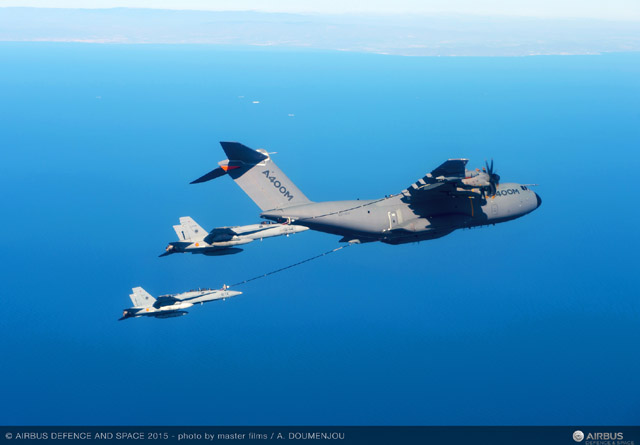Leeham News and Analysis
There's more to real news than a news release.
Boeing KC-46A first flight
Sept. 30, 2015: Boeing Friday launched the first flight of the USAF KC-46A aerial refueling tanker. The event was seven months late and all the program margin has been eaten up by the delays, but this was a milestone nonetheless.
The flight continued for four hours.
An additional video may be found here. Boeing’s press release is here. Boeing’s video with narration and test pilot reaction is here.
Bjorn’s Corner: USAF Tanker program
By Bjorn Fehrm
 25 September 2015, ©. Leeham Co: When Scott Hamilton asked me to give my view on his article “Pontifications: Duelling refuelling tankers” I accepted. I was not involved in the project and was only following it casually over the years.
25 September 2015, ©. Leeham Co: When Scott Hamilton asked me to give my view on his article “Pontifications: Duelling refuelling tankers” I accepted. I was not involved in the project and was only following it casually over the years.
I will also not give my view on what would have been the most suitable tanker for the US Air Force. I simply don’t have the relevant military competence for that, having never operated my fighters with aerial tanking nor been in an aerial tanker aircraft.
Where I have relevant competence is in writing military specifications for important aircraft procurements and the excerpts I have seen from the tanker RFQ on key specification points don’t impress. Let me explain.
Pontifications: Dueling refueling tankers
Sept. 21, 2015, © Leeham Co.: This Friday, Sept. 25, is the date that at long last, Boeing and the US Air Force expect the first flight of the KC-46A that is equipped with the fueling system.
A “bare” KC-46A made its first flight last December. Then it spent the next six months or so on the ground. First flight of the second KC-46A, the one with the fueling system, has been delayed several times. All the program margin is gone and it’s going to be a challenge for Boeing to stay on schedule to deliver 18 combat-ready KC-46As to the USAF by 2017–two short years away. To try and stay on schedule, Boeing started production of the the airplane concurrent with the flight test aircraft, a risky proposition that could result in major rework or other difficulties if Murphy’s Law comes into play.
The KC-46A is the successor to the KC-767 International tanker program, which was an industrial disaster. Only eight airplanes were produced, four for Italy and four

Boeing KC-46A makes its first flight Sept. 25, 2015. Photo via Google images.
for Japan. It ran years late and hundreds of millions of dollars over budget. There were flutter and design issues. These problems became part of the risk assessment by the USAF in the KC-X competition evaluation between Boeing and Northrop Grumman/EADS–and one of the reasons why the Air Force selected the Northrop KC-330 offering (later named the KC-30).
Boeing successfully challenged the contract award and won the next round with what became known as the KC-46A. Boeing claimed it benefited from lessons learned from the KC-767 International program.
Airbus Mobile FAL a victory for CEO Enders
Sept. 14, 2015, © Leeham Co., Mobile (AL): The opening of the Airbus Mobile (AL) A320 Final Assembly  Line (FAL) is viewed by some close associates as a personal victory for Tom Enders, the chief executive officer of Airbus Group.
Line (FAL) is viewed by some close associates as a personal victory for Tom Enders, the chief executive officer of Airbus Group.
Enders began the quest of a US FAL 10 years ago, when EADS (then the name of Airbus’ parent, now Air Group) joined with Northrop Grumman to bid on the US Air Force Refueling Tanker, the KC-X. The Boeing Co. was the competition, and supplied tankers to the USAF since the end of World War II.
Boeing’s 767 revitalized as a MOM stop gap, Part 3
By Bjorn Fehrm
Subscription required.
Introduction
Aug. 31 2015, ©. Leeham Co: After examining the characteristics of the Boeing 767 to serve the market segment that Boeing is studying for its Middle of the Market (MOM) requirement, the 225 passenger/5000nm sector, we will now finish the series by looking at how the 767 can be made economically more competitive.
We will study the influence of improved aerodynamics like Aviation Partners Boeing’s Split Scimitar Winglet for the 767. We will also look at what engine PIPs can provide and also look at what a re-engine could bring.
Finally we examine at what happens when we add crew costs, underway/landing fees and maintenance costs to form Cash Operating Costs (COC) followed by capital costs to form Direct Operating Costs (DOC).
Summary:
- Boeing’s 767 has the right cross section for passenger transportation in the 225 passenger/5000nm segment.
- Its wings and empennage are too large, however. We make them work harder by transporting the 767-300ER fuselage and passengers.
- We also introduce aerodynamic and engine improvements. Still, the fuel consumption per seat mile is considerably higher than modern alternatives.
- At a Cash Operating Cost and Direct Operating Cost level, the higher fuel consumption has less influence in today’s fuel prices. The result is that the 767-300ER becomes an interesting alternative as long as the fuel price stays low.
Air Force shouldn’t proceed with production rate decision, GAO said
- A chemical mislabeled and fueled into the first KC-46A means a delay of one month of its first flight, the USAF said yesterday.
Aug. 18, 2015, (c) Leeham Co. The US Air Force should not proceed with a decision giving Boeing the go-ahead for low-rate production on the KC-46A tanker “before it has adequate knowledge that

Click on image to enlarge.
the KC-46A can perform its aerial refueling mission,” the Government Accountability Office said in an April report.
This was before the latest delays, the impact of which remains undetermined, resulting from Boeing inserting the wrong chemical through a test KC-46A’s fueling system. The Seattle Times reported a vendor mislabeled the chemical. Boeing had already eaten up development margin in the timeline. When the GAO issued its April report, one of its periodic reviews of the program, the flight testing schedule had already been compressed to a mere three months before the low-rate production decision is due in October.
The flight testing is already running eight months behind schedule.
“Boeing is at risk of not meeting the entrance criteria needed to support the projected October 2015 low-rate production decision,” the GAO wrote in April, “and will have less knowledge about the reliability of the aircraft than originally planned. The small schedule margin that was built into the program has eroded….”
Fancher takes on KC-46A; FAA investigating Allegiant Air
July 30, 2015: Scott Fancher, regarded as the person to come in and take over troubled programs at Boeing, has been named to take over the KC-46A program.

Scott Fancher. Source: Boeing.
Fancher originally came to Boeing Commercial Airplanes from the Boeing defense unit to take over the 787 program at a time when development and design issues were rampant and the plane had yet to be delivered to a single customer.
After that was straightened out, Fancher took over new airplane programs and then moved to oversee development of the 777X, which is Boeing’s response to the Airbus A350 XWB. Although the 777X is a derivative, Boeing’s 747-8 derivative was two years late (in no small part due to the knock-on effects of the 787 program problems). Fancher’s charge with 777X was to be sure it comes in on time and on budget.
Pontifications: Boeing takes another charge on tanker program; What’s next?
July 20, 2015, © Leeham Co.: Boeing on Friday took another charges against its USAF aerial refueling tanker program, the KC-46A, this time $536m after taxes ($855m before taxes). This brings the charges to date to more than $800m after taxes ($1.3bn before taxes).
So much for my vacation and skipping Pontifications this week.
The new charge is split between Boeing Commercial Airplanes ($513m pre-tax) and
Boeing Defense, Space & Security ($322m pre-tax). This is because the KC-46A is based on the 767-

Japan’s KC-767. What about “lessons learned?” Photo via Google Images.
200ERF and BCA is principally in charge of the development.
Last week, the USAF–before the Boeing announcement–said it still expects the first production tankers to be delivered on time, in 2017, but Boeing Commercial’s recent track record of developing, producing and delivering airplanes on time and on budget leaves a lot to be desired.
Pontifications: Remaking the Armed Services
April 20, 2015, c. Leeham Co. A news item last week caught my eye about the Defense Department, defense spending and recapitalizing the US Armed Forces.
I don’t normally follow defense items at Leeham News and Comment. LNC is pretty much all-commercial, all the time. I’ve stepped outside this to follow commercially-derived air force tankers (Boeing 767, Airbus A330) and the P-8 Poseidon (the Boeing 737). I took rides on Trident nuclear ballistic missile subs and reported thusly. But this news article, which came about two weeks after my visit to Wall Street where some defense programs were discussed, prompts me to ask: Since we can’t afford the monies required to recapitalize the Armed Forces, what do we do?
I’m going to throw some ideas out and see where they land. I have no doubt some will be blasphemy. But here goes. Read more
Odds and Ends: Turkish tests A380; Boeing’s cash out; A400M milestone before Airbus Group results
18 Feb 2015: Turkish Airlines is contemplating testing A380 operations according to Blomberg by wet leasing two A380 from Malaysian Airlines. Turkish did the same when they tested the Boeing 777 before ordering it, then by wet leasing 777 from Jet Airways.
The deal would be good for both Turkish Airlines which could test the A380 to see if there is sufficient demand on their densest routes and for Malaysian Airlines as recent disasters has meant they no longer need the capacity of their six A380.
Probable destinations for Turkish would be London Heathrow and JFK. The two aircraft would be operated by Malaysian Airlines pilots and Malaysian would also furnish half the cabin crew during the first six months, the other half coming from Turkish. After the initial period there would be a dry lease phase where Turkish would continue with own crews. A third backup aircraft should be part of the deal.
Boeings CEO, Jim McNerney, has told investors at a Barclay’s investor conference that Boeing can use of to 80% of its free cash flow to pay back to investors without endangering planned R&D projects reports Reuters. Partly this comes from being able to keep the 777 production rates at around the current 100 aircraft per year in the bridge to the 777X. To entice airlines to continue buying the present 777, Boeing is working on improvements to the aircraft that will increase the efficiency by 2 %, half of which will be coming from improved GE90 engines and half from airframe changes.
McNerney further said the higher than expected deferred 787 productions costs were due to investments in production methods and the labor costs not coming down as expected. He also commented on the work on a new aircraft for the market between the present 737 and 787, “the 757 market” where he said the only thing which is clear is that the airlines want a slightly larger aircraft and we don’t see the market needing a solution in the near to mid term.
Airbus Groups results will be announced in a press conference from Munich Friday next week and their Military aircraft division is working on the outstanding improvements they owe A440M customers. Timely before the press conference they have now demonstrated the A400M working as a combined logistical transporter and tanker. In a series of rendezvous over four flights they transferred a total of 27 tonnes of fuel to two Spanish Air Force F18.
From the press release: “With a basic fuel capacity of 50.8 tonnes which can be increased by the use of extra cargo hold tanks, the A400M is the most capable tactical tanker in the market. The standard A400M aircraft has full provisions for air-to-air refuelling (AAR) operations already installed and only requires the rapid installation of the optional air-to-air refuelling kit to become a tanker.”
Our article shows that this is but one of the capabilities that should have been in delivered aircraft by now, Airbus is expected to announce further provisions for A400M development at the event.



